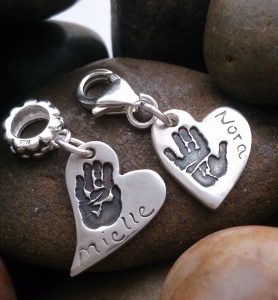If you’ve been shopping around and looking at different artists you may have noticed that some offer fine silver keepsakes and other offer sterling silver.
But what is the difference between fine silver and sterling silver?
The basic differences between fine silver and sterling silver is simply the purity of the silver. Fine silver is 99.9% pure silver, don’t ask me what the other 0.1% is, I do not know!
Sterling silver is a minimum of 92.5% silver. The other 7.5% is an alloyed metal, usually copper, which adds strength to the silver and makes it more durable for everyday use.
So what are the pros and cons of fine silver and sterling silver?
Fine Silver Pros
- It’s super shiny with a high luster, so it looks lovely when it’s polished up.
- It does not tarnish (darken) as quickly as sterling silver might.
- It has a higher silver content, so from a scrap metal perspective it would be higher in value.
- It has no nickel so will not cause allergic reaction.
- From a silver clay artist’s point of view it is easier to work with as there are no base metals to cause firescale during the firing process, also it can be torch fired so it requires less expensive equipment to use it.
Fine silver cons
- It’s very soft and scratches easily.
- Fine details such as fingerprints can eventually wear away
- If torch fired, it is not as strong as if it is kiln fired.
Sterling Silver Pros
- The copper content makes it up to 60% stronger than pure silver.
- *It is more resistant to scratching so better for everyday use.
Sterling Silver Cons
- It can be slightly duller in appearance and not quite as shiny as fine silver.
- It can tarnish quicker if not warn or polished regularly.
- SOME (not all) sterling silver can have nickel in the alloy mix which cause skin allergy. My sterling silver contains no nickel.
- From an artists perspective it is trickier to work with, it’s harder to get a smooth finish and the polishing stage takes more time and effort. It requires a kiln to fire and the cycle takes longer than for fine silver.
So which is better for fingerprint jewellery?
Well it really depends on what you want from your piece. If you are buying as keepsake jewellery that’s will be saved for special occasions and it likely to be stored in a box most of the time, then fine silver is a good choice for you. The purity means that it will not tarnish as quickly as sterling silver when it is not worn.
Fine silver can of course be worn every day and the print will last several years, however it will look scratched and worn far sooner than sterling silver.
If you plan to wear your fingerprint jewellery regularly, then sterling silver will stand up to wear and tear much better. If it’s worn it will not tarnish quickly, however if it is going to be stored in a box try to keep it in an airtight one to minimise the tarnish and the amount of polishing that is needed to keep it shiny.
All of my handmade keepsake jewellery is made from sterling Silver as standard. However if you would prefer a fine silver fingerprint or hand and footprint keepsake instead then just ask as I can work with that too. Take a look at what I have to offer at www.lastingtouch.co.uk
One of these handprint jewellery bracelet charms is sterling silver and the other is fine silver, but can you tell which is which? Feel free to comment below.

